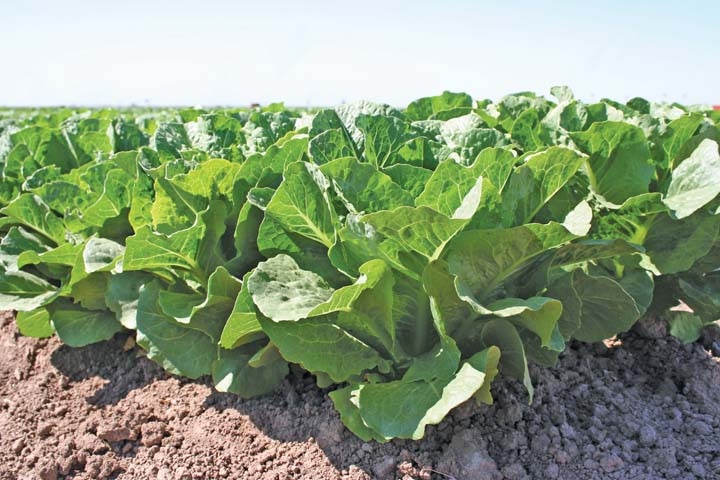September 8, 2010

Bagrada bug management tips for the low desert
By John Palumbo, UA Research Scientist and Extension Specialist
Bagrada bugs have shown up regularly on direct seeded and transplanted cole crops throughout the low desert. Numerous pest control advisers have reported the presence of adults on transplanted cauliflower and cabbage, plus seedling stands of broccoli.
Samples taken from cole crops in small experimental blocks at the Yuma Agricultural Center include up to 20 adults per 15 plants on four-day-old transplanted cabbage, and high levels of seedling damage in five-day-old broccoli stands where adult numbers have averaged as high as eight adults per 20 seedlings within 30 row feet.
Early trial results indicate that chemigation with bifenthrin (Discipline) at 6 ounces/acre provided 100 percent knockdown of Bagrada bug adults within 12 hours after chemigation in direct-seeded broccoli and transplanted cabbage.
Several trials are being initiated to assess control of Bagrada bugs with foliar- and soil-applied insecticides. Updates will be provided in the future.
For tips on Bagrada bug management based on field observations over the past year, click on this link: http://extension.arizona.edu/sites/extension.arizona.edu/files/resourcefile/resource/marcop/Bagrada%20Bug%20Management%20Tips%20for%20the%20Low%20Desert%20090810.pdf.
Contact Palumbo: (928) 782-3836 or [email protected].
Lettuce drop
Lettuce drop
By Mike Matheron, UA Extension Plant Pathologist
A presentation was made on the biology and management of Sclerotinia drop of lettuce at the Preseason Vegetable Workshop held in Yuma, Ariz. on Aug. 31, 2010.
Topics covered included: a comparison of differences and similarities in disease development caused by Sclerotinia minor and S. sclerotiorum; temperature and moisture requirements for airborne spore production by S. sclerotiorum; and cultural, biological, and chemical disease management tools.
To review the related PowerPoint presentation, click on this link:
http://cals.arizona.edu/crops/vegetables/advisories/docs/Matheron_Preseason_veg_workshopAug2010.pdf.
Contact Matheron: (928) 726-6856 or [email protected].
Using lettuce herbicides effectively
Using lettuce herbicides effectively
By Barry Tickes, UA Area Agriculture Agent
The three main lettuce herbicides - Balan, Prefar and Kerb - have the same mode of action but should be used differently to achieve the maximum weed control and crop safety.
All three products kill weeds by stopping cell division in seedling weeds but each differs in how it moves in the soil and plant.
Balan (Benefin) adheres very strongly to many soils and cannot be moved with water alone. Most weeds that emerge with the lettuce are located within the top half inch of the soil. It is difficult to move Balan even a quarter inch into the soil with sprinkler irrigation and impossible with furrow irrigation.
Balan must be mechanically incorporated. It is normally applied and mechanically incorporated prior to listing the beds. Mechanically incorporating Balan after listing will concentrate the herbicide into the bed top and increase weed control. It will also increase the possibility of crop injury.
Balan is the most active of the dinitoaniline herbicides which include Treflan, Prowl, and Balan. Care should be used when concentrating it near the crop seed.
Prefar (Bensulide) also adheres well to many soils and is difficult to move down to the germinating weed seeds. Mechanical incorporation often dilutes the herbicide and reduces weed control. It is most effective when a concentrated layer is moved into the soil with overhead sprinklers.
Tests have demonstrated that increasing the amount of sprinkler irrigation water improves weed control. Furrow irrigation does not incorporate the herbicide and results in poor weed control. Prefar can be effectively incorporated when chemigated through sprinklers.
Kerb (Pronamide) differs from Balan and Prefar as it does not adhere well to most soils. It is common to leach Kerb below germinating weed seeds in the low desert where relatively large amounts of water are used to germinate the crop. It is common practice to delay the application of the herbicide until just before or after weed seeds germinate.
Kerb also differs from Balan and Prefar because it moves or translocates in plants. It can move from the roots upward to the stems and leaves and downward from the leaves to the roots. It can kill sensitive small weeds post-emergence.
Prefar and Balan do not move in plants and work only on the root tip contact in the soil. These herbicides stop root growth at the point of contact but do not translocate to other parts of the plant.
More information, click on this online link: http://cals.arizona.edu/pubs/crops/az1143/az1143_8.pdf.
Contact Tickes: (928) 580-9902 or [email protected].
You May Also Like




